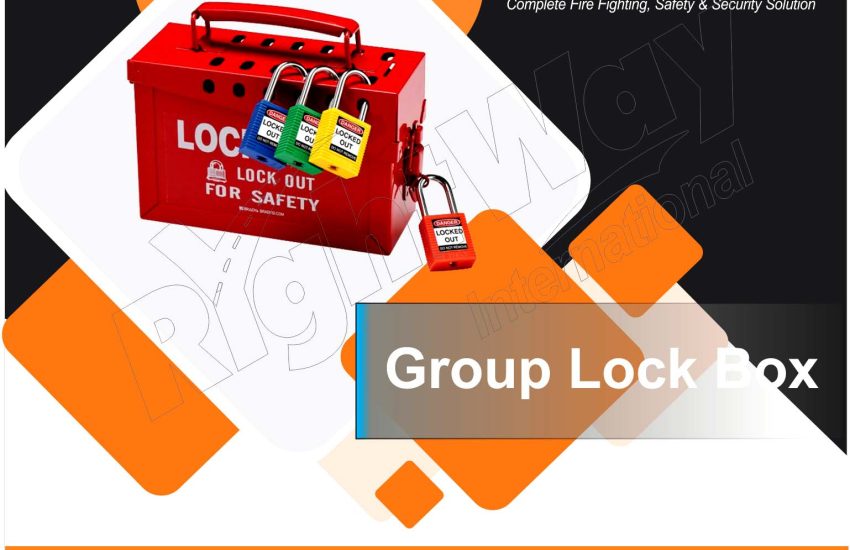Group Lock Box are essential tools used in lockout/tagout (LOTO) procedures, especially when multiple workers must safely isolate equipment during maintenance. These devices help coordinate lockout activities, prevent unauthorized access, and ensure regulatory compliance.
1. Purpose and Importance
Streamlining Lockout for Teams
Group lock boxes allow each worker involved in a task to place their personal padlock on a single lock box. Consequently, no one can access the equipment until all padlocks are removed, ensuring full control by all workers.
Blocking Unauthorized Access
Instead of relying on one person to control access, group lock boxes store equipment keys inside the box. As a result, only workers with locks on the box can retrieve them once work is complete.
Enhancing Overall Safety
Because equipment stays securely isolated until every worker removes their lock, group lock boxes significantly reduce the risk of accidental reactivation during repairs or servicing.
Ensuring Compliance
Many safety agencies, such as OSHA, require coordinated lockout/tagout procedures. Group lock boxes support these standards and help avoid regulatory penalties.
2. Types of Group Lock Boxes
Standard Lock Boxes
These basic models hold multiple padlocks and are ideal for routine LOTO tasks. Made from durable materials like steel or reinforced plastic, they suit most industrial settings.
Large Capacity Lock Boxes
For larger teams or complex systems, these boxes can accommodate dozens of locks. They are ideal for major shutdowns or jobs involving multiple departments.
Portable Lock Boxes
Portable models come with handles or straps, making them easy to transport between workstations. This flexibility is helpful when maintenance crews are on the move.
Wall-Mounted Lock Boxes
Mounted permanently in high-use areas, these lock boxes are perfect for facilities that require frequent and consistent LOTO enforcement.
Customizable Lock Boxes
Some models allow for customization, such as compartment dividers, labeling systems, or tamper-evident seals, to meet specific operational needs.
Electronic Lock Boxes
Advanced systems use keypads, RFID, or biometric access. Moreover, they offer features like digital access logs for enhanced accountability and security.
3. Key Benefits of Group Lock Boxes
Improved Workflow Coordination
Each worker applies their lock to the group box rather than individual energy sources. Therefore, the process is faster and easier to manage.
Stronger Safety Protocols
Because all keys to isolated energy sources are locked inside the box, workers are fully protected until everyone has finished their tasks.
Assured Compliance
Group lock boxes help organizations meet legal and safety standards. In doing so, they reduce liability and promote a culture of safety.
Built for Harsh Conditions
Constructed from rugged materials, these boxes resist impact, corrosion, and wear. As a result, they last longer even in demanding environments.
Easy to Use
Features like clear labeling, multiple locking points, and simple latch mechanisms make group lock boxes quick to deploy and remove.
4. Where Group Lock Boxes Are Used
Industrial Facilities
In heavy industry, group lock boxes manage the lockout of large machinery and electrical systems, making complex repairs safer for everyone involved.
Manufacturing Plants
Because manufacturing lines involve several moving parts and electrical circuits, group lock boxes help isolate these systems efficiently and protect workers during servicing.
Construction Sites
On job sites, group lock boxes centralize LOTO controls across multiple teams using tools, lifts, or electrical equipment. This coordination enhances job site safety.
Utilities and Infrastructure
For utility companies, these boxes manage the lockout of systems like power grids, water treatment stations, or telecommunication infrastructure, where precision is critical.
Commercial Buildings
Group lock boxes are useful in high-rise buildings, shopping centers, or hospitals to lock out elevators, HVAC systems, or high-voltage panels during maintenance.
5. Best Practices for Use
- Train all personnel in proper lockout/tagout procedures and the role of group lock boxes.
- Inspect the boxes regularly for damage, tampering, or missing components.
- Store the box in an accessible, visible location near the equipment it controls.
- Ensure all workers remove their locks before the box is unlocked and access is restored.
Conclusion
Group lock boxes are more than organizational tools—they are critical safeguards in multi-person maintenance tasks. They provide:
- A coordinated lockout process
- Improved team safety
- Compliance with safety standards


